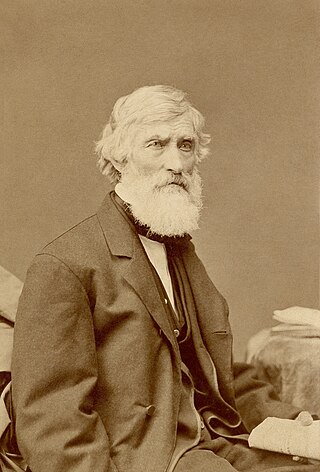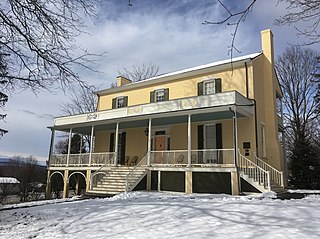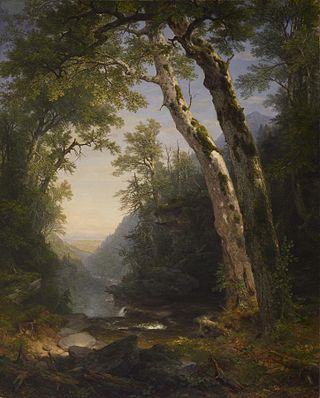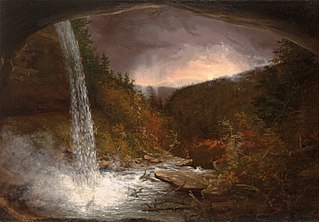
Frederic Edwin Church was an American landscape painter born in Hartford, Connecticut. He was a central figure in the Hudson River School of American landscape painters, best known for painting large landscapes, often depicting mountains, waterfalls, and sunsets. Church's paintings put an emphasis on realistic detail, dramatic light, and panoramic views. He debuted some of his major works in single-painting exhibitions to a paying and often enthralled audience in New York City. In his prime, he was one of the most famous painters in the United States.

The Hudson River School was a mid-19th-century American art movement embodied by a group of landscape painters whose aesthetic vision was influenced by Romanticism. Early on, the paintings typically depicted the Hudson River Valley and the surrounding area, including the Catskill, Adirondack, and White Mountains.

Thomas Cole was an English-born American artist and the founder of the Hudson River School art movement. Cole is widely regarded as the first significant American landscape painter. He was known for his romantic landscape and history paintings. Influenced by European painters, but with a strong American sensibility, he was prolific throughout his career and worked primarily with oil on canvas. His paintings are typically allegoric and often depict small figures or structures set against moody and evocative natural landscapes. They are usually escapist, framing the New World as a natural eden contrasting with the smog-filled cityscapes of Industrial Revolution-era Britain, in which he grew up. His works, often seen as conservative, criticize the contemporary trends of industrialism, urbanism, and westward expansion.

Asher Brown Durand was an American painter of the Hudson River School.

Sanford Robinson Gifford was an American landscape painter and a leading member of the second generation of Hudson River School artists. A highly-regarded practitioner of Luminism, his work was noted for its emphasis on light and soft atmospheric effects.

The Thomas Cole National Historic Site, also known as Cedar Grove, is a National Historic Landmark that includes the home and the studio of painter Thomas Cole, founder of the Hudson River School of American painting. It is located at 218 Spring Street, Catskill, NY, United States. The site provided Thomas Cole with a residence and studio from 1833 through his death in 1848.

The Catskills by Asher Brown Durand, an American engraver, portraitist, and landscape artist, was commissioned by William Thompson Walters in 1858.

Susie M. Barstow was an American painter associated with the Hudson River School who was known for her luminous landscapes.

Cross at Sunset is an oil on canvas painting by Thomas Cole. Believed to have been created around 1848, it was left unfinished due to his premature death that year.

Arch of Nero is an 1846 oil on canvas painting by Thomas Cole. It was on display at The Newark Museum of Art, but, as of July 2, 2021, was sold to the Philadelphia Museum of Art, and is currently on loan at the Mint Museum. The painting was sold on May 19, 2021, for $998,000 plus fees at a Sotheby auction, to a private foundation operated by the Florida-based collectors Thomas H. and Diane DeMell Jacobsen. They bought it "with the idea of keeping it on public view—an idea they promptly followed through on with their loan to the Philadelphia Museum of Art." Seventy "top art curators and scholars" sent an open letter to the Newark Museum of Art stating that the Arch of Nero "is an important and urgent address of America’s republicanism. It speaks to the founding ideal of the American nation, refers to America’s failure to live up to its own ideals, and is a clarion call for America to be the best version of itself.... For northeasterners such as Cole, the prime source of corruption of American republicanism was the Southern slavocracy and its unjust influence within the federal government. Cole made explicit his links between the corruption, decline, and fall of the Roman republic, and America’s present by clothing his figures in red, white, and blue."

Roman Campagna, also called Ruins of Aqueducts in the Campagna Di Roma, is an 1843 oil on canvas painting by Thomas Cole. It is currently displayed at the Wadsworth Atheneum in Connecticut.

The Dead Abel is an 1832 oil-on-paper painting by British-American painter Thomas Cole, the founder of the Hudson River School. It depicts the dead biblical figure Abel. It was originally intended to be a study for a larger painting; however, this other work was never created.

Kaaterskill Falls is an 1826 oil-on-canvas painting by British-American painter Thomas Cole, founder of the Hudson River School. It depicts the Kaaterskill Falls in Upstate New York.

The Fountain of Vaucluse is an 1841 oil on canvas painting by British-American painter Thomas Cole, founder of the Hudson River School. The work depicts the former home of Petrarch in Fontaine-de-Vaucluse, France.

Il Penseroso is an 1845 oil on canvas painting by British-American painter Thomas Cole, founder of the Hudson River School. The work is currently possessed by the Los Angeles County Museum of Art. Il Penseroso means "the thoughtful" in Italian.

View of Fort Putnam is an 1825 oil-on-canvas painting of the Hudson River with a view of Fort Putnam by British-American painter Thomas Cole, who founded the Hudson River School. It is currently owned by the Philadelphia Museum of Art.

Genesee Scenery, also called Mountain Landscape with Waterfall, is an 1847 oil on canvas painting by British-born American painter Thomas Cole, founder of the Hudson River School. The work depicts the Genesee River in New York State.

Sunset, View on the Catskill is an 1833 oil-on-wood painting by English-born American painter Thomas Cole. It is currently owned by the New-York Historical Society.

Summer Twilight, A Recollection of a Scene in New-England is an 1834 oil-on-wood painting by British-born American painter Thomas Cole, the founder of the Hudson River School. It is currently owned by the New-York Historical Society.



















